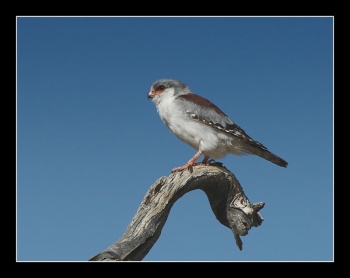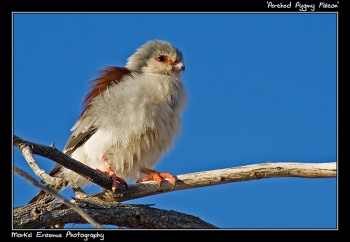(Imp sizes. Basic tidy-up. References updated) |
|||
| (6 intermediate revisions by 5 users not shown) | |||
| Line 1: | Line 1: | ||
| − | + | [[Image:Pygmy FalconBinty.jpg|thumb|400px|right| Photo by {{user|Binty|Binty}}<br />Northern Cape, [[South Africa]] November, 2017]] | |
| − | [[Image: | + | |
| − | + | ;[[:Category:Polihierax|Polihierax]] semitorquatus | |
| + | |||
==Identification== | ==Identification== | ||
| − | + | [[Image:Pygmy_Falcon.jpg|thumb|350px|right|Female or immature<br />Photo by {{user|Mybs|Mybs}}<br />Kgalagadi Transfrontier Park, [[South Africa]] December 2004]] | |
| + | 18–21 cm (7-8¼ in); a tiny raptor<br /> | ||
| + | Most often, the side of head is white all around the eye, more rarely with a dark stripe through the eye or with the grey cap reaching lower down. Rump is white, and in flight, the entire underside looks white. | ||
| + | |||
| + | Male has grey upperside while female has chestnut back, and immature is mostly like female. | ||
==Distribution== | ==Distribution== | ||
| − | Eastern and southern Africa: breeding in East Africa in northern and western Somalia, eastern Ethiopia, south-east Sudan and northern Uganda, Kenya and Tanzania. In southern Africa occurs in south Angola, eastern Namibia, Botswana and north-central South Africa. Resident. | + | Eastern and southern [[Africa]]: breeding in East Africa in northern and western [[Somalia]], eastern [[Ethiopia]], south-east [[Sudan]] and northern [[Uganda]], [[Kenya]] and [[Tanzania]]. |
| + | |||
| + | In southern Africa occurs in south [[Angola]], eastern [[Namibia]], [[Botswana]] and north-central [[South Africa]]. Resident. | ||
| + | |||
==Taxonomy== | ==Taxonomy== | ||
| − | Two subspecies are sometimes recognised: ''P. s. semitorquatus | + | This is a [[Dictionary_M-O#M|monotypic]] species<sup>[[#References|1]]</sup>. <br /> |
| + | Two subspecies are sometimes recognised: ''P. s. semitorquatus'' in southern Africa and ''P. s. castanotus'' in eastern Africa<sup>[[#References|3]]</sup>. | ||
| + | |||
==Habitat== | ==Habitat== | ||
| + | [[Image:Pygmy_falcon_by_Lekrom.jpg|thumb|350px|right|Female<br />Photo by {{user|Lekrom|Lekrom}}<br />Augrabies Falls National Park, [[South Africa]], May 2009]] | ||
Semi-desert, acacia savanna and open woodland. | Semi-desert, acacia savanna and open woodland. | ||
==Behaviour== | ==Behaviour== | ||
| − | Prey consists primarily of large insects and small reptiles. | + | ====Diet==== |
| + | Prey consists primarily of large insects, such as beetles, grasshopper and termites, also small reptiles and rodents. | ||
| + | ==References== | ||
| + | #{{Ref-Clements6thAug17}}#Sinclair et al. 2002. Birds of Southern Africa. Princeton Field Guides, Princeton, New Jersey, USA. ISBN 0-691-09682-1 | ||
| + | #Avibase | ||
| + | #Handbook of the Birds of the World Alive (retrieved Feb 2018) | ||
| + | {{ref}} | ||
==External Links== | ==External Links== | ||
{{GSearch|Polihierax+semitorquatus}} | {{GSearch|Polihierax+semitorquatus}} | ||
| − | [[Category:Birds]] | + | [[Category:Birds]] [[Category:Polihierax]] |
Revision as of 01:13, 14 February 2018
- Polihierax semitorquatus
Identification
18–21 cm (7-8¼ in); a tiny raptor
Most often, the side of head is white all around the eye, more rarely with a dark stripe through the eye or with the grey cap reaching lower down. Rump is white, and in flight, the entire underside looks white.
Male has grey upperside while female has chestnut back, and immature is mostly like female.
Distribution
Eastern and southern Africa: breeding in East Africa in northern and western Somalia, eastern Ethiopia, south-east Sudan and northern Uganda, Kenya and Tanzania.
In southern Africa occurs in south Angola, eastern Namibia, Botswana and north-central South Africa. Resident.
Taxonomy
This is a monotypic species1.
Two subspecies are sometimes recognised: P. s. semitorquatus in southern Africa and P. s. castanotus in eastern Africa3.
Habitat
Semi-desert, acacia savanna and open woodland.
Behaviour
Diet
Prey consists primarily of large insects, such as beetles, grasshopper and termites, also small reptiles and rodents.
References
- Clements, J. F., T. S. Schulenberg, M. J. Iliff, D. Roberson, T. A. Fredericks, B. L. Sullivan, and C. L. Wood. 2017. The eBird/Clements checklist of birds of the world: v2017, with updates to August 2017. Downloaded from http://www.birds.cornell.edu/clementschecklist/download/
- Sinclair et al. 2002. Birds of Southern Africa. Princeton Field Guides, Princeton, New Jersey, USA. ISBN 0-691-09682-1
- Avibase
- Handbook of the Birds of the World Alive (retrieved Feb 2018)
Recommended Citation
- BirdForum Opus contributors. (2024) Pygmy Falcon. In: BirdForum, the forum for wild birds and birding. Retrieved 25 April 2024 from https://www.birdforum.net/opus/Pygmy_Falcon






